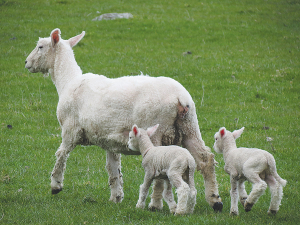Cows down
OPINION: It's not happening as fast as the greenies would like - they actually want all livestock other than Muscovy ducks and Tibetan Llamas to disappear entirely - but it is happening.
 The breeding ewe flock continues to decline with a 0.9% reduction following a 5.2% reduction in 2022.
The breeding ewe flock continues to decline with a 0.9% reduction following a 5.2% reduction in 2022.
A new study from Beef + Lamb NZ (B+LNZ) shows that land-use change is continuing to have an impact on livestock numbers.
The B+LNZ Stock Number Survey, which provides an assessment of New Zealand’s sheep flock and beef cattle herd, shows the breeding ewe flock continues to decline with a 0.9% reduction following a 5.2% reduction in 2022.
B+LNZ chief insight officer Julian Ashby says the breeding flock is the key indicator of future flock size.
“It’s trending down and is expected to continue to decline, one of the contributing factors is land-use change,” says Ashby.
“The amount of sheep and beef farmland being converted to forestry, along with the cumulative impact of a range of other policies on farm viability, is concerning.”
An updated analysis of land-use change from pastoral farming to large-scale forestry released by B+LNZ in July shows more than 200,000ha of sheep and beef farms had been sold into forestry in the last five years.
Ashby says this is now being reflected in livestock numbers.
“We have been saying for some time that there needs to be specific limits on the amount of forestry that can be used to offset fossil fuel emissions in the ETS,” he says.
“B+LNZ is not anti-forestry, we know many farmers are interested in integrating trees into their farms, but there must be some balance.”
On a more positive note, the forecast for lambing is expected to slightly increase this spring.
B+LNZ Economic Service chief economist Andrew Burtt says this is good news for both farmers and exporters and follows favourable Autumn conditions for ewes at mating.
Meanwhile, the total number of beef cattle at 30 June 2023, estimated at 3.81 million, is down 2.4%.
“The number of breeding cows and heifers increased 1.1 percent, with the South Island, mostly, leading the increase. Breeding cow numbers lifted as farmers chose to reduce weaner and trading cattle numbers,” says Burtt.
“The number of beef cattle weaners decreased 3.2 percent overall, but Southland farms bucked the trend and replenished weaner numbers by over 20 percent following two years of dry conditions.”
The National Wild Goat Hunting Competition has removed 33,418 wild goats over the past three years.
New Zealand needs a new healthcare model to address rising rates of obesity in rural communities, with the current system leaving many patients unable to access effective treatment or long-term support, warn GPs.
Southland farmers are being urged to put safety first, following a spike in tip offs about risky handling of wind-damaged trees
Third-generation Ashburton dairy farmers TJ and Mark Stewart are no strangers to adapting and evolving.
When American retail giant Cosco came to audit Open Country Dairy’s new butter plant at the Waharoa site and give the green light to supply their American stores, they allowed themselves a week for the exercise.
Fonterra chair Peter McBride says the divestment of Mainland Group is their last significant asset sale and signals the end of structural changes.

OPINION: Your old mate welcomes the proposed changes to local government but notes it drew responses that ranged from the reasonable…
OPINION: A press release from the oxygen thieves running the hot air symposium on climate change, known as COP30, grabbed your…